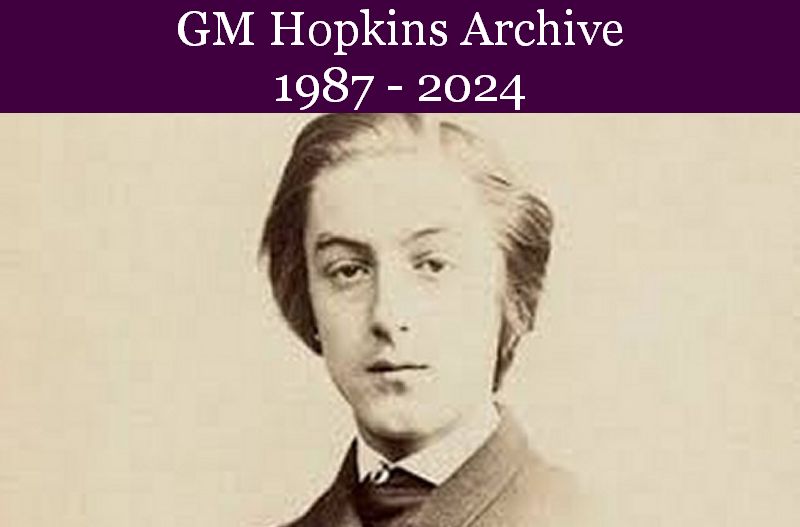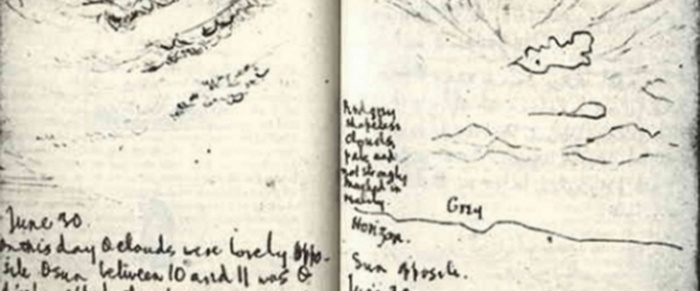Book Review: Hopeful Hopkins: Desmond Egan
Hopeful Hopkins: Desmond Egan;(120 pp, The Goldsmith Press, € 20)
Reviewed by William Adamson
Gerard Manley Hopkins is not the subject of many new studies. This is regrettable, as he holds a significant place within in the canon of poetry in English and has had, and continues to have, an incontestable influence on many poets of the 20th century and beyond, including Ezra Pound, Dylan Thomas, John Berryman, Elizabeth Bishop, Robert Lowell, and Denise Levertov. Indeed, it would be difficult to imagine modernist poetry without him.
This is why Desmond Egan’s latest contribution to Hopkins studies, Hopeful Hopkins, a collection of essays on, or based around the 19 century Jesuit priest and poet, is both necessary and refreshing. Desmond Egan has been directly involved with Hopkins for over three decades, primarily in his role as Artistic Director of the Gerard Manley Hopkins Society, Ireland, now in its 31st year.
A poet with 23 collections of poetry to his name, and translated into more than 25 languages, Desmond Egan also stands in that tradition of poets (including Hopkins himself) who, as well as producing poetry, have also had the critical engagement, ability and depth of understanding to write about their craft, a capacity all too sadly lacking in many of today’s poets. The title of his book signposts Egan’s critical purpose in these essays: to give the lie to the accepted and virtually unilateral notion that Hopkins was a poet of melancholy, a man alienated and despairing. And, whilst not denying that Hopkins was indeed plagued by bouts of depression, what today may be termed bipolar disorder, and fought with and doubted in himself, Egan’s precept is that, despite all this, he never surrendered to despair. Indeed, his suffering was both a transformative and life-affirming experience that constituted in no small measure the creative impulse in his writing. So much of Hopkins’s poetry is life affirming and “hopeful”, and his last words on his deathbed were “I am so happy, I am so happy. I loved my life.” The aim of this collection of essays is, then, to establish a corrective to the image of a “suffering, melancholic Hopkins”.
Hopeful Hopkins contains eight chapters ranging from the initial eponymous essay through topics as seemingly diverse as modernism, Hiberno-English, neurosis and art, Joyce, exile and a particularly personal final essay on the great Irish sculptor and writer James McKenna and Hopkins. Each essay is, in its own way, a valuable contribution to Hopkins scholarship. One chapter in particular in which Hopkins’s sense of fun is presented is in Egan’s essay on Hopkins and Hiberno-English, a scholarly discourse on the influence of Irish on the structure and syntax of the variety of English spoken in Ireland, and shedding light on Hopkins’s (and, we suspect, Egan’s) fascination with words and language, and the influence of Irishisms on his poetry. As Egan reminds us, Hopkins contributed no fewer than 89 entries to Joseph Wright’s English Dialect Dictionary, including the wonderful “He hasn’t enough sense to drive a pig down a boreen”. But it is Hopkins’s own forays into Hiberno-English which delight us. He begins a letter to his sister (written entirely in stage Irish brogue):
Me dear Miss Hopkins Im intoirely ashamed o meself. Sure its a wonder I could lave your iligant corspondance so long onanswered.
Or, in a letter written as a practical joke to a colleague, purporting to be the son of a respected livery and bait stables, asking for an introduction to a Dublin newspaper for occasional paregraphs or sporting inteligence” and able “to give any color which may be desired to reports of speeches or Proceedings subject to the Interests of truth which must always be the paremount consideration
. It is hard not to be reminded of Myles na gCopaleen and his columns in The Irish Times, and to imagine Hopkins writing a similar column about “The Brother” (spiritual rather than familial) in a delightful parody of the vernacular.
For me, however, two signature essays stand out for their scholarly and profound engagement with subjects of indispensable importance, revealing much about both Hopkins’s poetics and his influence. I refer to Desmond Egan’s close reading of the poem “As Kingfishers Catch Fire” and to his essay “James Joyce and Hopkins”.
Egan suggests that “it is worthwhile to explore in detail the structure of a Hopkins poem […] there is a world there: a wholeness of experience; a search; a sideways-glimpse in a new direction; a part-discovery… all resulting in a pushing of language beyond its ordinary function.” To illustrate this, he has chosen “As Kingfishers Catch Fire”, one of the most technically challenging of Hopkins’s sonnets and, as the critic Peter Milward has written, “the most characteristic expression of Hopkins’s aesthetic philosophy in poetic form.” In his almost forensic attention to the detail of the poem, to its grammar and lexicology, Egan impresses upon us the essential prerequisite of grammatical and phonological features to its semantics. He draws our attention, for example, to the separation of “its” from self” before the single word “myself” in line 7 of the poem, something disregarded by other scholars using printed versions which ignore this significant orthography (printing “itself”), thus overlooking the poem’s implicit theme, “So: everything in nature is filled with its self, its essence.” The subtitle of the essay is “Imagery and a Suggestion”, and it is to the imagery of the poem that Egan always returns – to Hopkins’s endeavour to “make words mimetic of an insight”, to paint pictures through rhyme in the sense of imposing or conveying meaning or plan through images: the dynamic, physical phenomena of the kingfishers and the dragonflies in line one, or the sound of stones tumbling into well with plucked strings and the tone of a ringing bell; “metaphor”, Egan tells us, “is at the mysterious heart of it.”
The essay on “James Joyce and Hopkins” is equally ground-breaking. Here, Egan raises the question of what, if at all, Hopkins’s influence on James Joyce might have been. The question is an important one, as both men, sui generis, radically played with and changed and challenged language.
At the beginning of the chapter, Egan quotes the distinguished Canadian Joyce scholar Hugh Kenner, who contended that “Joyce, so far as we can tell, never chanced to hear of Hopkins”. Egan is quick to respond: “For once, Kenner was not right.” It is true that in the great majority of scholarly works on Joyce, any mention made of the potential influence the Jesuit poet and teacher might have had on the Jesuit writer and pupil is notable by its absence. Indeed, in his work on Joyce the critical biographer hauteur of the great Irish writers (as well as Joyce, he wrote on Wilde, Becket and Yeats), Richard Ellmann, refers only once to Hopkins, dismissively stating that “in a state of exalted misery [he] held the U.C.D. classics chair during the eighties.”Herbert Gorman’s study of Joyce, although equally sparse, does, at least, refer to him as “the famous Father Gerard Manley Hopkins”. Joyce was seven when Hopkins died, and no meeting could ever have taken place. However, as Egan points out, to say that he never chanced to hear of him is stretching things too far. He divides his evidence between the anecdotal and that which is apparent in Joyce’s own writings. Egan cites evidence of the former in a report of a conversation in which Joyce referred to Hopkins as “a sort of English Mallarmé”, drawing the conclusion that Joyce, by linking both men, would therefore have seen him “as an experimenter, and more concerned with sound effects and musicality than expressing content.” This might apply equally to Joyce himself, and thus both men were linguistically undoubtedly on the same track. It is their unusual approach to language, their imaginative reorganisation of syntax, the compound adjectives and nouns, their neologisms and portmanteau words that unites them. And here Desmond Egan shows us conclusively what is apparent of Hopkins in Joyce’s work, making a convincing argument for his thesis that Joyce was directly influenced by Hopkins, and ending his chapter with a series of primary evidences: Joyce’s “dapplegray dawn” for Hopkins’s “dapple-dawn drawn falcon”; Joyce’s “God’s air, the Allfather’s air” for Hopkins’s “Wild air, world-mothering air”. These are but two of the indications for Joyce’s debt to Gerard Hopkins that Egan cites among many. He may well rest his case. Prefaced by Egan’s poem “Hopkins in Kildare”, and with an excellent introduction by Robert Smart, Professor of English at Quinnipiac University, USA, Hopeful Hopkins repays reading.
Desmond Egan, long recognized as one of the leading poets writing in Ireland today, has presented us with a selection of eloquent, erudite, and perceptive essays on Hopkins that are warmly sympathetic to their subject; both a candid and solid exercise in providing a corrective balance to the mistakenly accepted view that Hopkins was, as Norman White has written, “a sick and self-lacerating human being.”
In conclusion: Desmond Egan has a gift for coming up with arguments so thoughtfully selected, so exactly right, that they strike the reader as inevitable. Great poetry and outstanding critical commentary spring from such detail and intensity of response, and many of these essays are classics for their insight and style.
Hopkins Lectures 2017
Read Book Review:Hopeful Hopkins by Desmond Egan
Bridges Preface to Hopkins' Poems: William Adamson Univ. Ulm
Berryman John and GM Hopkins: Patrick Samway SJ
Neurosis and Art: Desmond Egan
Irish Exile and Terrible Sonnets : Robert Smart Quinnipiac


